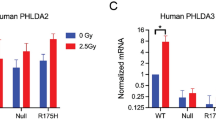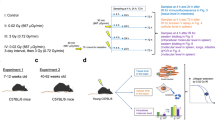Abstract
Ionizing radiation induces p53-dependent apoptosis in the spleen, providing a model system to study p53 regulated events in a normal cell type. We have developed an in vivo model that identifies genetic differences in the regulation of p53-mediated apoptosis and addresses whether altered post-translational events in the p53–p21/Rb axis modulate the sensitivity of cells to radiation-induced cell death in vivo. Splenocytes from mice with distinct genetic backgrounds (DBA/2 and C57BL/6) exhibit differences in the rate of apoptosis. Whilst no obvious strain differences in protein levels of Bcl-2 or the cyclin-CDKs were observed, early post-translational regulatory events in the p53–p21/Rb axis showed striking differences in the two mouse strains. Cells from C57BL/6 animals undergo more rapid apoptosis after irradiation resulting from elevated levels and rapid induction of p53, pronounced Rb-cleavage, and the absence of a sustained induction of p21. In contrast, cells from DBA/2 animals have a reduced rate of apoptosis following irradiation with elevated levels of hyperphosphorylated Rb and a sustained induction of the p21 protein that is coincident with the C-terminal phosphorylation of p53. These data suggest that quantitative differences in the level of p21 protein can affect the rate of apoptosis in vivo, consistent with the view that p21 is an anti-apoptotic effector of p53. However, striking differences in the Rb protein–caspase cleavage or hyperphosphorylation–in the same cell type, but in different genetic backgrounds, demonstrates that p53-dependent apoptosis can be modulated in vivo by genetic factors that impinge upon the pro- or anti-apoptotic potential of Rb. In addition, we show that Rb cleavage is p53-dependent and that its phosphorylation status can be uncoupled from p21 expression. This study highlights the possibility that genetic factors can be identified that affect differential sensitivity of cells to ionizing radiation in vivo
This is a preview of subscription content, access via your institution
Access options
Subscribe to this journal
Receive 50 print issues and online access
$259.00 per year
only $5.18 per issue
Buy this article
- Purchase on Springer Link
- Instant access to full article PDF
Prices may be subject to local taxes which are calculated during checkout







Similar content being viewed by others
References
Almasan A, Yin Y, Kelly RE, Lee EY, Bradley A, Li W, Bertino JR, Wahl GM . 1995 Proc. Natl. Acad. Sci. USA 92: 5436–5440
An B, Dou QP . 1996 Cancer Res. 56: 438–442
An B, Jin JR, Lin P, Dou QP . 1996 FEBS Lett. 399: 158–162
Asada M, Yamada T, Ichijo H, Delia D, Miyazono K, Fukumuro K, Mitzutani S . 1999 EMBO J. 18: 1223–1234
Ball KL . 1997 Prog. Cell Cycle Res. 3: 125–134
Ball KL, Lane DP . 1996 Eur. J. Biochem. 237: 854–861
Ball KL, Lain S, Fahraeus R, Smythe C, Lane DP . 1997 Curr. Biol. 7: 71–80
Blaydes JP, Hupp TR . 1998 Oncogene 17: 1045–1052
Blaydes JP, Craige AL, Wallace M, Traynor NJ, Gibbs NK, Hupp TR . 2000 Oncogene 19: 3829–3839
Boutillier AL, Trinh E, Loeffler JP . 2000 Oncogene 19: 2171–2178
Bouvard V, Zaitchouk T, Vacher M, Duthu A, Canivet M, Choisy-Rossi C, Nieruchalski M, May E . 2000 Oncogene 19: 649–660
Bowen C, Spiegel S, Gelmann EP . 1998 Cancer Res. 58: 3275–3281
Bunz F, Hwang PM, Torrance C, Waldman T, Zhang Y, Dillehay L, Williams J, Lengauer C, Kinzler KW, Vogelstein B . 1999 J. Clin. Invest. 104: 263–269
Clarke AR, Purdie CA, Harrison DJ, Morris RG, Bird CC, Hooper ML, Wyllie AH . 1993 Nature 362: 849–852
Day ML, Foster RG, Day KC, Zhao X, Humphrey P, Swanson P, Postigo AA, Zhang SH, Dean DC . 1997 J. Biol. Chem. 272: 8125–8128
Dou QP, An B, Antoku K, Johnson DE . 1997 J. Cell. Biochem. 64: 586–594
Dou QP, An B, Will PL . 1995 Proc. Natl. Acad. Sci. USA 92: 9019–9023
Dou QP, Lui VW . 1995 Cancer Res. 55: 5222–5225
Dulic V, Kaufmann WK, Wilson SJ, Tlsty TD, Lees E, Harper JW, Elledge SJ, Reed SI . 1994 Cell 76: 1013–1023
el-Deiry WS, Harper JW, O'Connor PM, Velculescu VE, Canman CE, Jackman J, Pietenpol JA, Burrell M, Hill DE, Wang Y . 1994 Cancer Res. 54: 1169–1174
Esposito F, Russo L, Russo T, Cimino F . 2000 FEBS Lett. 470: 211–215
Fan G, Ma X, Kren BT, Steer CJ . 1996 Oncogene 12: 1909–1919
Fiscella M, Zhang H, Fan S, Sakaguchi K, Shen S, Mercer WE, Vande Woude GF, O'Connor PM, Apella E . 1997 Proc. Natl. Acad. Sci. USA 94: 6048–6053
Fredersdorf S, Milne AW, Hall PA, Lu X . 1996 Am. J. Pathol. 148: 825–835
Freemerman AJ, Vrana JA, Tombes RM, Jiang H, Chellappan SP, Fisher PB, Grant S . 1997 Leukemia 11: 504–513
Gervais JL, Seth P, Zhang H . 1998 J. Biol. Chem. 273: 19207–19212
Gorospe M, Cirielli C, Wang X, Seth P, Capogrossi MC, Holbrook NJ . 1997 Oncogene 14: 929–935
Gorospe M, Wang X, Guyton KZ, Holbrook NJ . 1996 Mol. Cell Biol. 16: 6654–6660
Gottlieb E, Oren M . 1998 EMBO J. 17: 3587–3596
Haas-Kogan DA, Kogan SC, Levi D, Dazin P, T'Ang A, Fung YK, Israel MA . 1995 EMBO J. 14: 461–472
Harbour JW, Dean DC . 2000 Nat. Cell. Biol. 2: E65–E67
Haupt Y, Rowan S, Oren M . 1995 Oncogene 10: 1563–1571
Hupp TR, Lane DP . 1994 Curr. Biol. 4: 865–875
Kern SE, Kinzler KW, Bruskin A, Jarosz D, Friedman P, Prives C, Vogelstein B . 1991 Science 252: 1708–1711
Knudsen KE, Weber E, Arden KC, Cavenee WK, Feramisco JR, Knudsen ES . 1999 Oncogene 18: 5239–5245
Komarova EA, Christov K, Faerman AI, Gudkov AV . 2000 Oncogene 19: 3791–3798
Lees E . 1995 Curr. Opin. Cell. Biol. 7: 773–780
Lowe SW, Schmitt EM, Smith SW, Osborne BA, Jacks T . 1993 Nature 362: 847–850
Macleod KF, Sherry N, Hannon G, Beach D, Tokino T, Kinzler K, Vogelstein B, Jacks T . 1995 Genes Dev. 9: 935–944
Merritt AJ, Potten CS, Kemp CJ, Hickman JA, Balmain A, Lane DP, Hall PA . 1994 Cancer Res. 54: 614–617
Midgley CA, Owens B, Briscoe CV, Thomas DB, Lane DP, Hall PA . 1995 J. Cell Sci. 108: 1843–1848
Mittnacht S . 1998 Curr. Opin. Genet. Dev. 8: 21–27
Mittnacht S, Lees JA, Desai D, Harlow E, Morgan DO, Weinberg RA . 1994 EMBO J. 13: 118–127
Miyashita T, Reed JC . 1995 Cell 80: 293–299
Morana SJ, Wolf CM, Li J, Reynolds JE, Brown MK, Eastman A . 1996 J. Biol. Chem. 271: 18263–18271
Muschel RJ, Soto DE, McKenna WG, Bernhard EJ . 1998 Oncogene 17: 3359–3363
Nomura T . 1982 Nature 296: 575–577
Nomura T, Kinuta M, Hongyo T, Nakajima H, Hatanaka T . 1992 J. Radiat Res. (Tokyo) 33: 109–123
Oren M . 1999 J. Biol. Chem. 274: 36031–36034
Park JA, Kim KW, Kim SI, Lee SK . 1998 Eur. J. Biochem. 257: 242–248
Roderick TH . 1963 Radiation research 20: 631–639
Sherr CJ, Roberts JM . 1999 Genes Dev. 13: 1501–1512
Somasundaram K . 2000 Front Biosci. 5: D424–D437
Strasser A, Harris AW, Jacks T, Cory S . 1994 Cell 79: 329–339
Suzuki A, Tsutomi Y, Miura M, Akahane K . 1999 Oncogene 18: 1239–1244
Tan X, Martin SJ, Green DR, Wang JYJ . 1997 J. Biol. Chem. 272: 9613–9616
Tan X, Wang JY . 1998 Trends Cell. Biol. 8: 116–120
Tian H, Wittmack EK, Jorgensen TJ . 2000 Cancer Res. 60: 679–684
Waldman T, Kinzler KW, Vogelstein B . 1995 Cancer Res. 55: 5187–5190
Waldman T, Zhang Y, Dillehay L, Yu J, Kinzler K, Vogelstein B, Williams J . 1997 Nat. Med. 3: 1034–1036
Wang H, Grand RJ, Milner AE, Armitage RJ, Gordon J, Gregory CD . 1996 Oncogene 13: 373–379
Wang J, Guo K, Wills KN, Walsh K . 1997 Cancer Res. 57: 351–354
Watson GE, Lorimore SA, Clutton SM, Kadhim MA, Wright EG . 1997 Int. J. Radiat. Biol. 71: 497–503
Weil MM, Zia X, Lin Y, Stephens LC, Amos CI . 1997 Genomics 45: 626–628
Whitaker LL, Hansen MF . 1997 Oncogene 15: 1069–1077
Wilson JW, Pritchard DM, Hickman JA, Potten CS . 1998 Am. J. Pathol. 153: 899–909
Wyllie AH, Kerr JF, Currie AR . 1980 Int. Rev. Cytol. 68: 251–306
Xiong Y, Zhang H, Beach D . 1992 Cell 71: 505–514
Acknowledgements
M Wallace is supported by the Cancer Research Campaign, PJ Coates and EG Wright are supported by grants from the Medical Research Council, and KL Ball holds a Senior Cancer Research Fellowship from the Cancer Research Campaign.
Author information
Authors and Affiliations
Rights and permissions
About this article
Cite this article
Wallace, M., Coates, P., Wright, E. et al. Differential post-translational modification of the tumour suppressor proteins Rb and p53 modulate the rates of radiation-induced apoptosis in vivo. Oncogene 20, 3597–3608 (2001). https://doi.org/10.1038/sj.onc.1204496
Received:
Revised:
Accepted:
Published:
Issue Date:
DOI: https://doi.org/10.1038/sj.onc.1204496
Keywords
This article is cited by
-
The RNA helicase p68 (DDX5) is selectively required for the induction of p53-dependent p21 expression and cell-cycle arrest after DNA damage
Oncogene (2013)
-
In GFP with high risk HPV-18E6 fusion protein expressed 293T and MCF-7 cells, the endogenous wild-type p53 could be transiently phosphorylated at multiple sites
Journal of Experimental & Clinical Cancer Research (2008)
-
Maternal effects of the scid mutation on radiation-induced transgenerational instability in mice
Oncogene (2007)
-
Altered structure and deregulated expression of the tumor suppressor gene retinoblastoma (RB1) in human brain tumors
Molecular and Cellular Biochemistry (2007)
-
Heritability of DNA-damage-induced apoptosis and its relationship with age in lymphocytes from female twins
British Journal of Cancer (2006)



